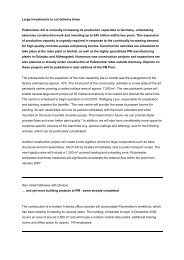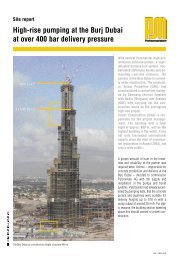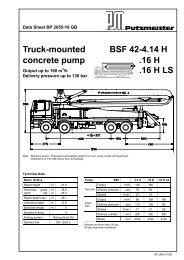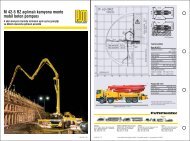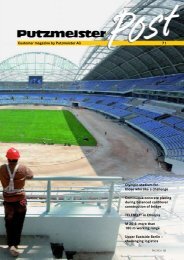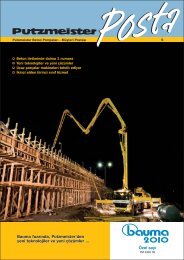2005 - Putzmeister
2005 - Putzmeister
2005 - Putzmeister
You also want an ePaper? Increase the reach of your titles
YUMPU automatically turns print PDFs into web optimized ePapers that Google loves.
Special concrete<br />
Large boom concrete pumps inject<br />
"Bügelbauten" bookend buildings<br />
With the completion of the two 46 m tall<br />
office towers, the last construction section<br />
of the new Berlin main train station<br />
began at the end of July <strong>2005</strong>. The imposing<br />
building is being constructed on the<br />
site of the former Lehrter train station<br />
and, after completion, will be used as the<br />
central terminal for north/south and<br />
east/west rail transport in the German<br />
capital. According to forecasts, 300,000<br />
passengers and visitors are expected at the<br />
Lehrter train station each day.<br />
The pump service provider LICHTNER<br />
used three <strong>Putzmeister</strong> concrete pumps to<br />
inject the complicated floor structure of<br />
steel sections with a specially developed<br />
concrete, as well as to concrete the floors.<br />
68 69<br />
Berlin's first main train station<br />
As in London and Paris, Berlin never<br />
had a central main train station in the<br />
past. Due to the star-shaped railway<br />
network, the railway lines ended at the<br />
edge of the capital city. At the end of<br />
the 19th century, a suburban railway<br />
line connected the city's most important<br />
long-distance train stations.<br />
The old Lehrter train station, opened in<br />
1871, was severely damaged in the<br />
Second World War, and the ruins of the<br />
former building were blasted at the end<br />
of the 50s. Thereafter, the Berlin suburban<br />
railway used the site as a stopping<br />
point. After the fall of the Berlin<br />
wall, intensive work went into plans<br />
for a central traffic node for the<br />
German capital city. In 1998, work on<br />
the new train station began.<br />
At the end of May 2006, shortly before<br />
the Football World Cup, the Lehrter<br />
train station is to be officially opened<br />
as "Europe's most modern train terminal"<br />
– according to DEUTSCHE<br />
BAHN AG.<br />
The aboveground part of the new Berlin<br />
main train station (east/west direction) has<br />
four platforms for long-distance and regional<br />
trains and two platforms for suburban<br />
railway traffic, 10 m above street level. For<br />
the north/south connection, eight platforms<br />
for long-distance and regional trains as<br />
well as two for the underground line U5<br />
will be constructed 15 m below ground.<br />
A huge glass roof with a length of 321 m,<br />
which is installed above the east/west<br />
wing, will act as protection against bad<br />
weather and will allow daylight to reach<br />
even the deeper floors.<br />
The critical section of the project is the<br />
completion of the bookend buildings. These<br />
are two 46 m tall office buildings which, at<br />
a length of 87 m, straddle the east-west line<br />
like bridges at the intersection of the railway.<br />
The two twelve storey buildings were<br />
initially constructed as four vertical tower<br />
halves, which were tilted by 90° in summer<br />
<strong>2005</strong> and welded. This procedure, which is<br />
not carried out every day, was chosen to ensure<br />
that the railway traffic flowing beneath<br />
the buildings did not have to experience<br />
disruption caused by a long construction<br />
period.<br />
The carcass construction work for the solid<br />
structure of the bookend buildings was<br />
carried out by WAYSS & FREYTAG<br />
INGENIEURBAU AG.<br />
Highly effective deflocculant helps the<br />
concrete spread into "dead angles"<br />
The four bookend buildings consist of<br />
numerous steel pipe sections which are<br />
designed as loadbearing composite constructions.<br />
26<br />
PM 3723 GB<br />
Lowering of the bookend buildings over the east/west line of the Lehrter train station (Photo: DB AG/Reiche)<br />
Even in the narrowest of spaces, the two<br />
<strong>Putzmeister</strong> M 42 and M 52 can be set up by<br />
the concrete pump service provider LICHTNER<br />
– as shown here for concreting the floors<br />
67<br />
Amongst other things, the pylons, the<br />
external and internal supports of the bases<br />
of the bookend buildings and the lattice<br />
girders of the four 1,250 ton bookend halves<br />
with their numerous upper, middle and<br />
lower flanges were injected with concrete.<br />
The contract for this work was awarded to<br />
LICHTNER pump service provider from<br />
Velten, which, over a period of months,<br />
used its <strong>Putzmeister</strong> truck-mounted<br />
BSF 36.16 HLS, BSF 42.16 H and<br />
BSF 52.16 H concrete pumps for the work.<br />
The steel sections contain a very densely<br />
set reinforcement and, up to a height of<br />
10 m, are injected with a specially developed<br />
concrete with strength class C45/55 in<br />
one operation. The mixture breakdown<br />
includes an increased fines content and a<br />
highly effective plasticising admixture<br />
based on polycarboxylatether (PCE), which<br />
displays an even higher deflocculation<br />
effect compared with the familiar super<br />
deflocculants. As the pumped concrete contains<br />
practically no more air particles, and<br />
has a very free-flowing consistency (F5 to<br />
F6), additional shaking is not necessary.<br />
Injection through 150 m long 65 mm<br />
delivery hose<br />
At the start of the injection work, the boom<br />
length of the BSF 36.16 HLS was still<br />
sufficient. As the construction progressed,<br />
however, LICHTNER started to use its<br />
concrete pumps with 42 and 52 metre<br />
vertical reach. In order to also be able to<br />
Up to three concrete pumps simultaneously inject the numerous<br />
steel sections of the bookend buildings. Picture shows M 36.<br />
reach the farther removed filler pipes, a<br />
tapering, which reduced the line diameter<br />
to 65 mm, was connected to the machine's<br />
boom tip instead of an end hose. The<br />
connection of up to 150 metres of hose<br />
meant a significantly increased working<br />
range could be achieved. As expected, the<br />
hydraulic pressure of the pumps increased,<br />
but remained within a reasonable limit.<br />
Filler pipes situated beneath the steel sections<br />
fill them with quantities of 5 to 6 m 3 .<br />
The slow ascent of the concrete in the constructional<br />
element discharges the available<br />
air upwards. The filler pipes in the injected<br />
steel sections are closed with guillotines<br />
and concrete is prevented from escaping by<br />
cutting the line. Injection of the bookend<br />
buildings started in April <strong>2005</strong> and completion<br />
is planned for the end of <strong>2005</strong>.<br />
In addition to injecting the steel sections<br />
with special concrete, the two LICHTNER<br />
large boom pumps BSF 42.16 H and<br />
BSF 52.16 H are also used for concreting<br />
the floors. Their boom length means they<br />
can also reach higher levels of the bookend<br />
buildings. To do this, the large boom<br />
pumps need a C 40/50 concrete with a<br />
maximum particle size of 16 mm, and the<br />
individual sections each hold approximately<br />
120 m 3 . For this work too, the pipe at the<br />
boom tip of the truck-mounted concrete<br />
pump was reduced to 65 mm diameter<br />
through the addition of a tapering and a<br />
flexible hose with a length of up to 30 m<br />
was connected.<br />
The floors are concreted with the boom tip extended<br />
and with a 65 mm delivery hose attached<br />
Guillotines are used to close the steel sections after<br />
injection<br />
70<br />
71<br />
27<br />
PM 3723 GB



![Data sheet BSA 1005 D SV (TB 2206) [.pdf; 459.58 kb] - Putzmeister](https://img.yumpu.com/51174022/1/184x260/data-sheet-bsa-1005-d-sv-tb-2206-pdf-45958-kb-putzmeister.jpg?quality=85)
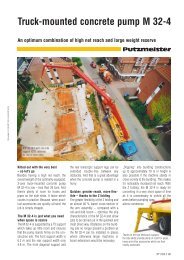
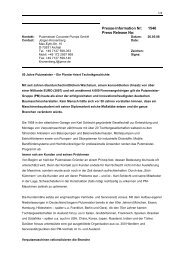
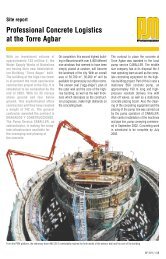
![Typenblatt CS 3095 [.pdf; 202.40 kb] - Putzmeister](https://img.yumpu.com/50530164/1/184x260/typenblatt-cs-3095-pdf-20240-kb-putzmeister.jpg?quality=85)
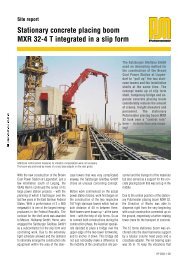
![M 47 Broşürü [.pdf; 527.92 kb] - Putzmeister](https://img.yumpu.com/49631771/1/190x141/m-47-brosuru-pdf-52792-kb-putzmeister.jpg?quality=85)

